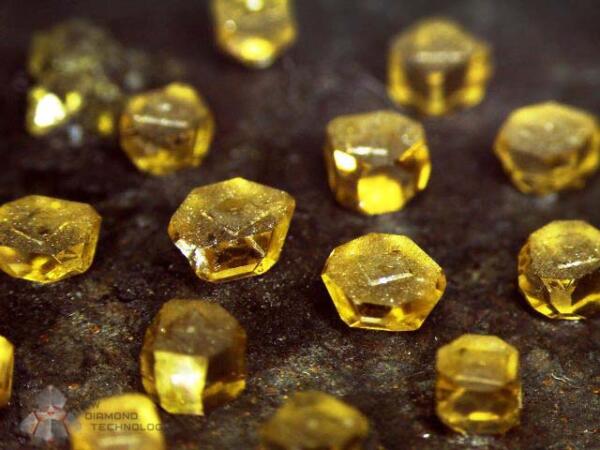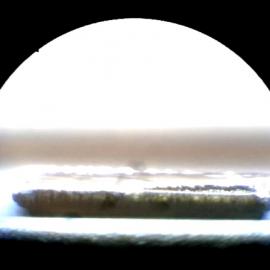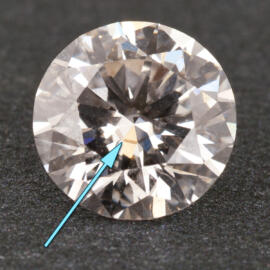What Are Lab Grown Diamonds?
Synthetics, Simulants, and the Truth: An Introduction to Man-Made Diamonds

In the simplest terms, lab grown diamonds are diamonds that have been made by people instead of mined out of the earth. If it’s so simple, you might wonder why there’s an entire article below this sentence. The complexity arises from the fact that lots of different terms have been used to describe lab grown diamonds and their cousins, and not everyone uses these terms in the same way. So, let’s begin with some vocabulary.
Synthetic. Understanding this term correctly is the key that unlocks this entire question. Synthetic can mean artificial or even fake. Synthetic can also mean man-made, copied, unreal, or even imitation. But, in this context, what do we mean when we say “synthetic diamond”?
In the gemological world, synthetic is a highly technical term. When speaking technically, synthetic gems are man-made crystals with the same crystal structure and chemical composition as the specific gem that is being created. Therefore, a “synthetic diamond” has the same crystal structure and chemical composition as a natural diamond. The same cannot be said of the many imitation or fake gems that are often, incorrectly, described as synthetic diamonds. This misrepresentation has seriously confused what the term “synthetic” means, and it’s why most producers of man-made diamonds prefer the term “lab grown” over “synthetic.”

In order to appreciate this fully, it helps to understand a little bit about how lab grown diamonds are made. There are two techniques to grow single crystal diamonds. The first and oldest is the High Pressure High Temperature (HPHT) technique. This process starts with a seed of diamond material and grows a full diamond just like nature does under extremely high pressure and temperature.
The newest way to grow synthetic diamonds is the Chemical Vapor Deposition (CVD) technique. In the CVD process, a chamber is filled with a carbon rich vapor. Carbon atoms are extracted from the rest of the gas and deposited on a wafer of diamond crystal which establishes the crystal structure as the gemstone grows layer by layer. You can learn more about how lab grown diamonds are made from our main article on the different techniques. The important takeaway for now is that both of these processes are highly advanced technologies that produce crystals with the exact same chemical structure and optical properties as natural diamonds. Now, let’s compare lab grown diamonds to some of the other gems that you might have heard of.
Lab Grown Diamonds Compared with Diamond Simulants
When is a synthetic not a synthetic? The answer is when it is a simulant. Simulants are gems that look like a real, natural gem but are actually another material. So, a clear or white sapphire can be a diamond simulant because it looks like a diamond. That white sapphire can be natural or, here’s the trick, synthetic sapphire. The key to understanding the simulant issue is not how the gem is made (natural vs synthetic), but that it is a substitute that looks like another gem. So, we can say that a man-made white sapphire is a “synthetic sapphire” or that it can be used as a “diamond simulant,” but it would be incorrect to say that it is a “synthetic diamond” because it does not have the same chemical structure as a diamond.
A white sapphire, marketed and disclosed as a white sapphire, is a sapphire. But, if it is used in place of a diamond, then it is a diamond simulant. Simulant gems, again, are attempting to mimic another gem, and if they are not clearly disclosed as simulants they are considered fakes. A white sapphire is not, by nature, a fake (in fact it is a beautiful and highly valuable gem). But if it is being sold as a diamond, it becomes a fake. Most gem simulants are trying to imitate diamonds, but there are also simulants for other valuable gemstones (sapphires, rubies, etc.).
Here are some of the more popular diamond simulants.
- Synthetic Rutile was introduced in the late 1940s and used as an early diamond simulant.
- Next on the man-made diamond simulant play is Strontium Titanate. This material became a popular diamond simulant in the 1950s.
- The 1960s brought the development of two simulants: Yttrium Aluminum Garnet (YAG) and Gadolinium Gallium Garnet (GGG). Both are man-made diamond simulants. It is important to reiterate here that just because a material can be used as a diamond simulant does not make it a “fake” or a bad thing. YAG, for example, is a very useful crystal that lies at the heart of our laser welder.
- The most popular diamond simulant by far today is synthetic Cubic Zirconia (CZ). It is cheap to produce and sparkles very brilliantly. It is a great example of a synthetic gemstone that is a diamond simulant. CZs are very often, mistakenly, referred to as synthetic diamonds.
- Synthetic Moissanite also creates some confusion. It is a man-made, synthetic gem that actually has some diamond-like properties. For example, diamonds are especially good at transferring heat, and so is Moissanite. This is important because the most popular diamond testers use heat dispersion to test if a gemstone is a diamond. However, Moissanite has a completely different chemical structure than diamond and different optical properties. For example, Moissanite is double-refractive whereas diamond is single-refractive.
Since Moissanite tests like diamond (due to its heat dispersal properties), people think it is diamond or synthetic diamond. However, since it does not have the same crystal structure or chemical composition of diamond, it is not a synthetic diamond. Moissanite is a diamond simulant.
It may be becoming clear at this point why the term “synthetic” is so confusing in this context. With Moissanite we have a synthetic gem that looks and acts a lot like diamond but should never be referred to as a “synthetic diamond.” Because of this, along with most of the jewelry industry, we tend to use the term “lab grown diamond” to refer to a true synthetic diamond that shares the same chemical properties as a natural diamond, and we tend to avoid the term “synthetic diamond” given how much confusion it can create.
There is another diamond simulant that creates a lot of confusion. Diamond coated Cubic Zirconia (CZ) gems are produced using the same Chemical Vapor Deposition (CVD) technology that is used to produce lab grown diamonds. With diamond coated CZs, a very thin layer of synthetic diamond material is added on top of a CZ. The nanocrystalline diamond particles are only about 30 to 50 nanometer’s thick. That is about 30 to 50 atoms thick or 0.00003mm. Or, should it be said, extremely thin. CVD diamond coated Cubic Zirconia are not synthetic diamonds. They are glorified Cubic Zirconia diamond simulants only. They do not have the same hardness or crystal structure of diamonds. Like some eye glasses, CVD diamond coated Cubic Zirconia has an extremely thin diamond coating only. However, this does not stop some unscrupulously marketers from calling them synthetic diamonds. Now, you know better.
Lab Grown Diamonds Compared with Natural Diamonds
So, now that we know what lab grown diamonds are not, it’s time to talk about what they are. How do lab grown diamonds compare to natural diamonds? The answer is based in the definition of synthetic. As we have learned, a synthetic diamond has the same crystal structure and chemical composition as a natural diamond. Therefore, they look just like the natural gemstone. They sparkle the same. They have the same hardness. Side by side, lab grown diamonds look and act just like natural diamonds.
The differences between a natural and a lab grown diamond stem from how they were made. Lab grown diamonds are man-made in a lab while natural diamonds are created in the earth. Nature is not a controlled, sterile environment, and natural processes vary abundantly. Therefore, the results are not perfect. There are many types of inclusions and structural signs that nature made a given gem.
Lab grown diamonds, on the other hand, are made in a controlled environment. They have signs of a regulated process that is not like nature. Furthermore, human efforts are not perfect and they leave their own flaws and clues that humans made a given gem. The types of inclusions and subtle variations in crystal structure are one of the main ways to differentiate between lab grown and natural diamonds. You can also learn more about how to tell if a diamond is lab grown or natural from our main article on the subject.
The bottom line: lab grown diamonds are just like natural diamonds, but man-made. Diamond simulants are not the same as diamonds. They have the general look of diamonds but not the same properties. Now that you understand what a lab grown diamond is, you can better decide if a lab grown diamond is right for you. And, you can rest assured that the gemologists at Arden Jewelers are here to answer any questions you have, clearly explain the origins of the diamonds we sell, and find you the perfect diamond in your budget.


The price of lab grown diamonds should not as high as mine diamonds because they’re not natural